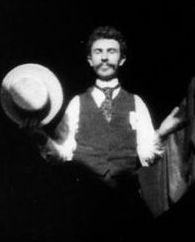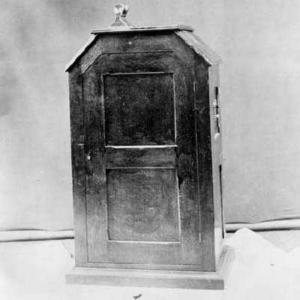 SKC Films Library |
| SKC Films Library >> Technology >> Photography >> Cinematography |
| Kinetoscope early motion-picture viewing device In 1888, Eadweard Muybridge visited Thomas Alva Edison's laboratory and proposed that they collaborate and combine Muybridge's Zoopraxiscope with Edison's phonograph. Although Edison turned Muybridge down, he was intrigued enough by the concept that on October 17 of that year he filed a patent caveat (preliminary claim) with the U.S. Patent Office describing his ideas for a device which would "do for the eye what the phonograph does for the ear" -- record and reproduce objects in motion. Edison called the invention a "Kinetoscope," using the Greek words "kineto," meaning "movement" and "scopos," meaning "to watch." The task of developing Edison's concept into a working prototype was assigned to William Kennedy Laurie Dickson, who had been employed by Edison since the spring of 1883, and Dickson's chief assistant Charles A. Brown. William K. L. Dickson Edison's original idea involved recording pinpoint photographs, 1/32 of an inch wide, directly on to a cylinder made of an opaque material for positive images or of glass for negatives. An audio cylinder would provide synchronized sound, while the rotating images were viewed through a microscope-like tube. Edison envisaged projection to be achieved by shining a light source through the microphotographs from inside the cylinder. Initial ideas for getting intermittent motion included the use of electric sparks inside the cylinder, which provided intermittent illumination, and a start-stop movement of the cylinder itself. The photographic medium for presenting the microphotographs required serious thought. Experimentation with coating the cylinder with photographic emulsion was considered but deemed impractical. A breakthrough came around June 1889, when the Edison Laboratory began working with sensitized celluloid sheets, supplied by John Carbutt, that could be wrapped around the cylinder, providing a far superior base for the recording of photographs. Although the photographic sheets produced high-quality images, the cylinder concept ultimately proved impractical and was abandoned, as were attempts at synchronizing film and sound. In August 1889, while attending the Universal Exposition in Paris, Edison met French physiologist Étienne-Jules Marey, who used a continuous roll of film in his Chronophotographe to produce a sequence of still images, Upon his return to the United States, Edison filed another patent caveat, on November 2, which described a Kinetoscope based not just on a flexible filmstrip, but one in which the film was perforated to allow for its engagement by sprockets, making its mechanical conveyance much more smooth and reliable. The development of celluloid film in roll form by The Eastman Company spurred the inventive process, and by 1890 Dickson and his new assistant William Heise were working on a machine that exposed a strip of film in a horizontal-feed mechanism. The first Kinetoscope using flexible film was demonstrated to a convention of the National Federation of Women’s Clubs on May 20, 1891. The device consisted of a wooden cabinet in which a loop of horizontally configured 19 mm (3/4 inch) film ran around a series of spindles. The film, with a single row of perforations engaged by an electrically powered sprocket wheel, was drawn continuously beneath a magnifying lens. Beneath the film was an electric lamp, and between the lamp and the film a revolving shutter with a narrow slit. As each frame passed under the lens, the shutter permitted a flash of light so brief that the frame appeared to be frozen. This rapid series of apparently still frames appeared, thanks to the persistence of vision phenomenon, as a moving image. The lab also developed a motor-powered camera, the Kinetograph, capable of shooting with the new sprocketed film. To govern the intermittent movement of the film in the camera, allowing the strip to stop long enough so each frame could be fully exposed and then advancing it quickly (in about 1/460 of a second) to the next frame, the sprocket wheel that engaged the strip was driven by an escapement disc mechanism. left: Kinetoscope
with cabinet open A patent for both the Kinetograph and the Kinetoscope was filed on August 24, 1891. In this patent, the width of the film was specified as 35mm, and allowance was made for the possible use of a cylinder. By the time a fully functioning prototype was completed in 1892 the horizontal arrangement had been replaced by a vertical one. The first public demonstration of the Kinetoscope was held at the Brooklyn Institute of Arts and Sciences on May 9, 1893. WEB SOURCES SEE ALSO |
| SKC Films Library >> Technology >> Photography >> Cinematography This page was last updated on 10/17/2017. |

